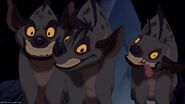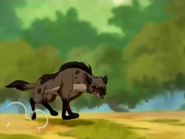The Spotted Hyena (Crocuta crocuta), also known as the Laughing Hyena is a famed scavenger and often dines on the leftovers of other predators. But these hardy beasts are also skilled hunters that will take down wildebeest or antelope. They also kill and eat birds, lizards, snakes, and insects. In an increasingly overpopulated Africa, hyenas and humans come into frequent contact. In fact, the Maasai people of Kenya and Tanzania actually leave their dead to be consumed by hyenas. However, these intelligent and bold animals will raid food stores and crops and are blamed for many livestock and even some human deaths. In some areas they have been heavily hunted as destructive pests.
Spotted hyenas are the largest of three hyena species. Brown and striped hyenas are the other two. Although hyenas appear similar to dogs, they are actually more closely related to cats. They live throughout much of Africa and eastwards through Arabia to India. Spotted hyenas live together in large groups called clans that may include up 80 individuals and are led by females.
Spotted hyenas have good hearing and sharp eyesight at night. They are fast and can run for long distances without tiring. Packs work together effectively to isolate a herd animal, sometimes one that is ill or infirm, and pursue it to the death. The victors often squabble over the spoils, either among themselves or with other powerful animals like lions. Spotted hyenas are quite vocal and make a wide variety of sounds, including the "laughing" that has long been associated with their name.
Social Behavior[]
Spotted hyenas are social animals which live in large communities (referred to as "clans") which can consist of at most 80 individuals. Group-size varies geographically; in the Serengeti, where prey is migratory, clans are smaller than those in the Ngorongoro Crater, where prey is sedentary. Spotted hyena clans are more compact and unified than wolf packs, but are not as closely knit as those of African wild dogs. Females dominate males, with even the lowest ranking females being dominant over the highest ranking males. It is typical for females to remain with their natal clan, thus large clans usually contain several matrilines, whereas males typically disperse from their natal clan at the age of 2½ years. The clan is a fission-fusion society, in which clan-members do not often remain together, but may forage alone or in small groups. High-ranking hyenas maintain their position through aggression directed against lower-ranking clan-members. Spotted hyena hierarchy is nepotistic; the offspring of dominant females automatically outrank adult females subordinate to their mother. However, rank in spotted hyena cubs is greatly dependent on the presence of the mother; low-ranking adults may act aggressively toward higher-ranking cubs when the mother is absent. Although individual spotted hyenas only care for their own young, and males take no part in raising their young, cubs are able to identify relatives as distantly related as great-aunts. Also, males associate more closely with their own daughters rather than unrelated cubs, and the latter favour their fathers by acting less aggressively toward them.
Spotted hyena societies are more complex than those of other carnivorous mammals, and are remarkably similar to those of cercopithecine primates in respect to group size, structure, competition and cooperation. Like cercopithecine primates, spotted hyenas use multiple sensory modalities, recognise individual conspecifics, are conscious that some clan-mates may be more reliable than others, recognise third-party kin and rank relationships among clan-mates, and adaptively use this knowledge during social decision making. Also, like cercopithecine primates, dominance ranks in hyena societies are not correlated with size or aggression, but with ally networks. In this latter trait, the spotted hyena further show parallels with primates by acquiring rank through coalition. However, rank reversals and overthrows in spotted hyena clans are very rare. The social network dynamics of spotted hyenas are determined by multiple factors. Environmental factors include rainfall and prey abundance; individual factors include preference to bond with females and with kin; and topological effects include the tendency to close triads in the network. Female hyenas are more flexible than males in their social bonding preferences.
The higher ranking adult spotted hyenas tend to have higher telomere length, thus are healthier, naturally live longer, and reproduce more.
Territory size is highly variable, ranging from less than 40 km2 in the Ngorongoro Crater to over 1,000 km2 in the Kalahari. Home ranges are defended through vocal displays, scent marking and boundary patrols. Clans mark their territories by either pasting or pawing in special latrines located on clan range boundaries. Clan boundaries are usually respected; hyenas chasing prey have been observed to stop dead in their tracks once their prey crosses into another clan's range. Hyenas will however ignore clan boundaries in times of food shortage. Males are more likely to enter another clan's territory than females are, as they are less attached to their natal group and will leave it when in search of a mate. Hyenas travelling in another clan's home range typically exhibit bodily postures associated with fear, particularly when meeting other hyenas. An intruder can be accepted into another clan after a long period of time if it persists in wandering into the clan's territory, dens or kills.
























